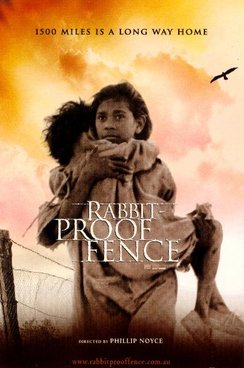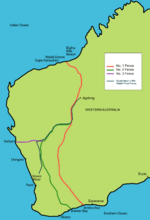Rabbit-Proof Fence facts for kids
Quick facts for kids Rabbit-Proof Fence |
|
|---|---|

Theatrical release poster
|
|
| Directed by | Phillip Noyce |
| Produced by | Phillip Noyce Christine Olsen John Winter |
| Screenplay by | Christine Olsen |
| Starring | Everlyn Sampi Tianna Sansbury Laura Monaghan David Gulpilil Kenneth Branagh |
| Music by | Peter Gabriel |
| Cinematography | Christopher Doyle |
| Editing by | Veronika Jenet John Scott |
| Studio | Rumbalara Films Olsen Levy Showtime Australia |
| Distributed by | Becker Entertainment |
| Release date(s) | 4 February 2002 |
| Running time | 93 minutes |
| Country | Australia |
| Language | Walmajarri English |
| Budget | USD$6 million |
| Money made | USD$16.2 million |
Rabbit-Proof Fence is a 2002 Australian drama film directed and produced by Phillip Noyce based on the 1996 book Follow the Rabbit-Proof Fence by Doris Pilkington Garimara. It is loosely based on a true story concerning the author's mother Molly Craig, as well as two other Aboriginal girls, Daisy Kadibil and Gracie, who escape from the Moore River Native Settlement, north of Perth, Western Australia, to return to their Aboriginal families, after being placed there in 1931. The film follows the Aboriginal girls as they walk for nine weeks along 1,500 miles (2,400 km) of the Australian rabbit-proof fence to return to their community at Jigalong, while being pursued by white law enforcement authorities and an Aboriginal tracker. The film illustrates the official child removal policy that existed in Australia between approximately 1905 and 1967. Its victims now are called the "Stolen Generations".
The soundtrack to the film, called Long Walk Home: Music from the Rabbit-Proof Fence, is by Peter Gabriel. British producer Jeremy Thomas, who has a long connection with Australia, was executive producer of the film, selling it internationally through his sales arm, HanWay Films. In 2005 the British Film Institute included it in the BFI list of the 50 films you should see by the age of 14.
Contents
Plot
In 1931, two sisters – 14-year-old Molly and 8-year-old Daisy – and their 10-year-old cousin Gracie live in the Western Australian town of Jigalong. The town lies along the northern part of one of the fences making up Australia's rabbit-proof fence (called Number One Fence), which runs for over one thousand miles.
Over a thousand miles away in Perth, the official Protector of Western Australian Aborigines, A. O. Neville (called Mr. Devil by them), signs an order to relocate the three girls to the Moore River Native Settlement. The children are referred to by Neville as "half-castes", because they have one white and one Aboriginal parent. Neville's reasoning is portrayed as: the Aboriginal people of Australia are a danger to themselves, and the "half-castes" must be bred out of existence. He plans to place the girls in a camp where they, along with all half-castes of that age range, both boys and girls, will grow up. They will then presumably become labourers and servants to white families, regarded as a "good" situation for them in life. Eventually if they marry, it will be to white people and thus the Aboriginal "blood" will diminish. As such, the three girls are forcibly taken from their families at Jigalong by a local constable, Riggs, and sent to the camp at the Moore River Native Settlement, in the south west, about 90 km (55 miles) north of Perth.

Neville spreads word that Gracie's mother is waiting for her in the town of Wiluna. The information finds its way to an Aboriginal traveller who "helps" the girls. He tells Gracie about her mother and says they can get to Wiluna by train, causing her to leave the other two girls in an attempt to catch a train to Wiluna. Molly and Daisy soon walk after her and find her at a train station. They are not reunited, however, as Riggs appears and Gracie is recaptured. The betrayal is revealed by Riggs, who tells the man he will receive a shilling for his help. Knowing they are powerless to aid her, Molly and Daisy continue their journey. In the end, after a nine-week journey through the harsh Australian outback, having walked the 2,400 km (1,500 miles) route along the fence, the two sisters return home and go into hiding in the desert with their mother and grandmother. Meanwhile, Neville realizes he can no longer afford the search for Molly and Daisy and decides to end it.
Epilogue
The film's epilogue shows recent footage of Molly and Daisy. Molly explains that Gracie has died and she never returned to Jigalong. Molly also tells us of her own two daughters; she and they were taken from Jigalong back to Moore River. She managed to escape with one daughter, Annabelle, and once again, she walked the length of the fence back home. However, when Annabelle was three years old, she was taken away once more, and Molly never saw her again. In closing, Molly says that she and Daisy "... are never going back to that place".
Cast
- Everlyn Sampi as Molly Craig
- Tianna Sansbury as Daisy Craig Kadibil
- Laura Monaghan as Gracie Fields
- David Gulpilil as Moodoo the Tracker
- Jason Clarke as Constable Riggs
- Kenneth Branagh as A. O. Neville
- Ningali Lawford as Maude, Molly's mother
- Myarn Lawford as Molly's grandmother
- Deborah Mailman as Mavis
- Garry McDonald as Mr. Neal
- Roberta Lynch as The Teacher
- Roy Billing as Police Inspector
- Natasha Wanganeen as Nina, Dormitory Boss
Production
The film is adapted from the book Follow the Rabbit-Proof Fence, by Doris Pilkington Garimara, which is the second book of her trilogy documenting her family's stories. The other two books are Caprice: A Stockman’s Daughter (1991) and Under the Wintamarra Tree (2002)
Accolades
Wins
-
- Film Script—the Pacific Film and Television Commission Award (Christine Olsen)
- Best Film (Phillip Noyce, Christine Olsen, John Winter)
- Best Original Music Score (Peter Gabriel)
- Best Sound (Bronwyn Murphy, Craig Carter, Ricky Edwards, John Penders)
- Best Director (Phillip Noyce)
- Best Screenplay—Adapted (Christine Olsen)
- Best Actress (Everlyn Sampi)
- Best Production Design (Roger Ford)
- shortlisted for The Premier's Young People's History Prize (Christine Olsen and Phillip Noyce)
- Audience Award, Audience Favourite Feature (Phillip Noyce)
- ASPI Award (Phillip Noyce)
- Golden Castle (Phillip Noyce)
- People's Choice Award: Best Feature-Length Fiction Film (Phillip Noyce)
- Audience Award (Phillip Noyce)
- Audience Award (Phillip Noyce)
- Audience Award (Phillip Noyce)
- Freedom of Expression Award
- Best Director (Phillip Noyce)
- Special Citation (Phillip Noyce, also for The Quiet American (2002))
- Audience Award: Best Foreign Film (Phillip Noyce)
- Audience Award: Feature Film (Phillip Noyce)
- Director of the Year (Phillip Noyce, also for The Quiet American (2002))
- Audience Award: Best Foreign Film (Phillip Noyce)
Nominations
-
- Best Actor in a Supporting Role (David Gulpilil)
- Best Cinematography (Christopher Doyle)
- Best Costume Design (Roger Ford)
- Best Direction (Phillip Noyce)
- Best Editing (Veronika Jenet, John Scott)
- Best Production Design (Roger Ford)
- Best Screenplay Adapted from Another Source (Christine Olsen)
- Best Actor—Female (Everlyn Sampi)
- Best Cinematography (Christopher Doyle)
- Best Film
- Best Music Score (Peter Gabriel)
- Golden Frog (Christopher Doyle)
- Golden Trailer: Best Independent
- Golden Globe: Best Original Score—Motion Picture (Peter Gabriel)
- Golden Reel Award: Best Sound Editing in Foreign Features (Juhn Penders, Craig Carter, Steve Burgess, Ricky Edwards, Andrew Plain)
- Exposé
- Human Rights
- Best Performance in a Feature Film—Supporting Young Actress (Everlyn Sampi)
- Best Performance in a Feature Film—Young Actress Age Ten or Under (Tianna Sansbury)
See also
 In Spanish: Rabbit-Proof Fence para niños
In Spanish: Rabbit-Proof Fence para niños
- Cinema of Australia
- Survival film, about the film genre, with a list of related films

